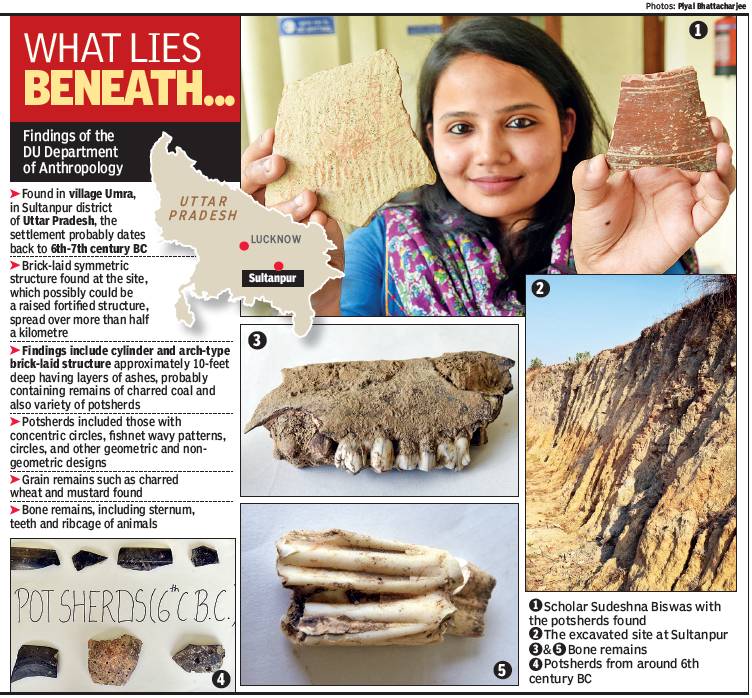Umra
This is a collection of articles archived for the excellence of their content. |
Ancient settlement
Mohammad Ibrar, March 17, 2021: The Times of India

From: Mohammad Ibrar, March 17, 2021: The Times of India
DU Dept Unearths Settlement On Highway Site, May Date Back To 6th-7th Century BC
Archaeologist Says It Could Be Part Of Ancient Trade Route
New Delhi:
On March 2, professor Manoj Kumar Singh from Delhi University’s department of anthropology got an email from a student in Lucknow about a few artifacts being found in Umra village in Sultanpur district. After assessment and excavation, a team of researchers has likely discovered a human settlement from 6th to 7th century BCE.
Based on the terracotta structures, charred foodgrains, animal bones and pottery, an archaeologist from Archaeological Survey of India (ASI) reached the conclusion that the settlement could have been a part of the ancient trade route towards Allahabad.
The first-year DU student, Kartik Mani Tripathi, discovered the ancient remains on land that was dug up for an Uttar Pradesh government-sponsored highway project. “Kartik sent mails to many authorities, including ASI, but got no response. He then emailed me on March 2. The next day, two of my researchers, Sudeshna Biswas and Ravinder, reached the spot,” said Singh.
Biswas said the site was in a hamlet called Jawahar ka Purwa. “We found remains of pottery, potsherds, grains, bricks and bones and reported it to our professor. He then led an immediate preliminary investigation of the unreported remains. The site, located on a raised platform close to Gomti river, might have been a permanent settlement,” she added.
Singh said locals called the place “Itawah”, or locale of bricks. “The villagers had found mounds of large unusual bricks. They had used mud, potsherds and other precious debris and bricks to build their houses. The bricks were huge and heavy compared with contemporary ones. Due to their longevity, almost every house in the area had used them,” he added.
The researchers also found a cylinder and arch-type brick structure approximately 10 feet deep with layers of ashes. “The potsherds were of various designs and had been stylised with concentric circles, fishnet wavy patterns, circles, and geometric as well as non-geometric designs. The exploration yielded a variety of raw materials, predominantly red ware. The other relatively scarce sherds were of black ware and polished black ware,” said Biswas.
Bhuvan Vikram, superintendent archeologist with ASI, told TOI, “The photographs of the potsherds clearly show that they are of the northern black polished ware culture, which was prevalent in the first millennia BCE. We can safely say that the site belongs to around the 7th Century BCE in the Kushana period.”
“The entire region is rich in history, This was also the period when Buddha was travelling. In those times, cities were flourishing. This could be the part of a trade route, which makes it significant. We hope to find more such sites,” added Vikram.
The charred remains of mustard, paddy, etc made it appear to the researchers that grains were stacked or stored in the area and food had been cooked there.
In his letter to ASI director general V Vidyavathi, the professor stated that the site could be an epitome of new findings in the field of archaeology and ancient history. However, he warned that due to the quarrying for the highway, ASI should look into the matter at the earliest to stop further destruction of the site. Singh told TOI that he hoped that DU would lead the excavation with assistance from ASI.